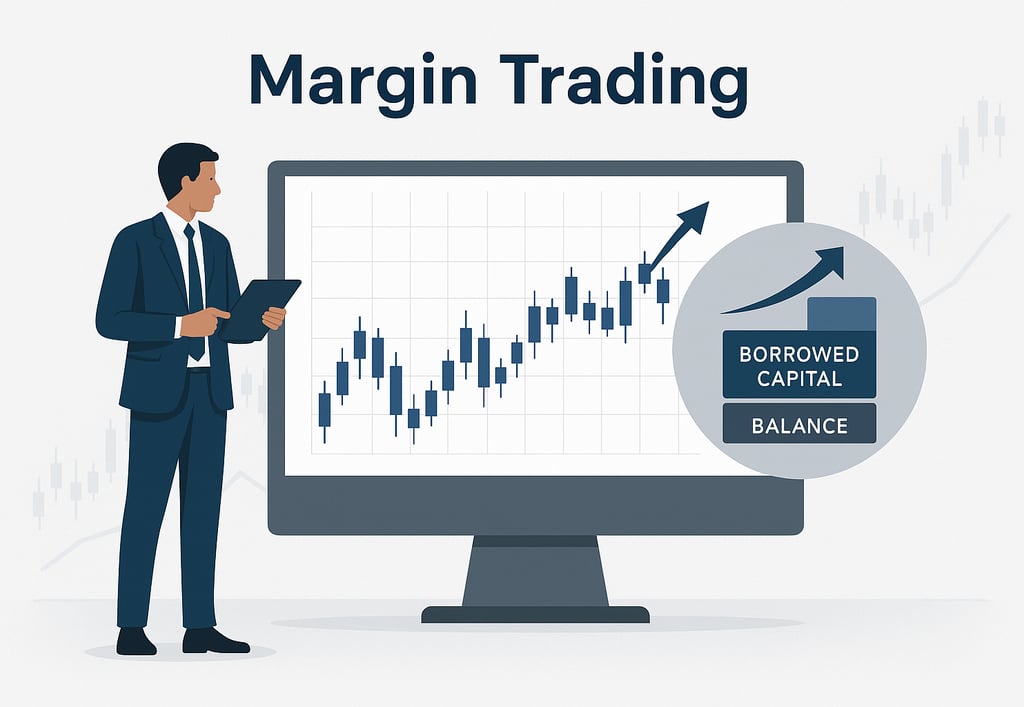What Is a Margin Account India? Full Guide for Traders (2025)
4/2/20252 min read


What Is a Margin Account in India? Full Guide for Traders (2025)
A margin account enables traders to borrow funds from their broker to buy more securities than they could afford with their own capital. This leveraged approach can boost gains, especially in intraday or F&O trading, but also increases the risk of losses.
What Is a Margin Account?
A margin account is a type of brokerage account where the broker lends money to the trader to purchase additional securities. These borrowed funds are backed by the securities bought and require the trader to maintain a minimum balance, known as the margin requirement.
This feature is frequently used in active trading strategies such as Futures & Options or short-term equity trades.
How Does a Margin Account Work in India?
• Account Setup:
You begin by opening a margin-enabled trading account and signing a margin agreement with your broker.
• Initial Margin Requirement:
You must fund a certain percentage (usually 20–30%) of the total trade value. The broker covers the rest as a loan.
• Leverage:
With margin, you can control a larger position than your available capital. For example, with ₹1,00,000 and 5x leverage, you can take positions worth ₹5,00,000.
• Margin Call:
If your account value drops due to market volatility, the broker may issue a margin call, requiring you to deposit more funds or liquidate positions.
Benefits of a Margin Account
• Increased Buying Power: Trade larger positions with less capital.
• Higher Profit Potential: Leverage magnifies gains during favorable movements.
• Flexibility for Traders: Especially useful for intraday and derivatives segments.
Risks of Margin Trading
• Amplified Losses: Leverage increases downside risk if the trade moves against you.
• Margin Calls: A fall in market value can trigger compulsory fund infusion or position liquidation.
• Interest Costs: You pay interest on the borrowed amount daily until repaid.
• Market Volatility Risk: Margin can quickly erode capital during sharp market swings.
Margin Account vs Cash Account
Capital Source:
• Margin Account: Uses a mix of your own money and broker’s funds.
• Cash Account: Trades executed only with your deposited funds.
Risk Exposure:
• Margin Account: High, due to leverage.
• Cash Account: Lower, as there’s no borrowing involved.
Interest Charges:
• Margin Account: Yes, interest is charged on the borrowed capital.
• Cash Account: No interest payments
Trading Scope:
• Margin Account: Suited for intraday, F&O, short-term trades.
• Cash Account: Ideal for long-term, delivery-based investing.
SEBI Regulations on Margin Trading (2025)
• Brokers are required to collect margins upfront based on SEBI’s VAR + ELM framework.
• Only approved securities are eligible for margin trading.
• Peak margin norms must be followed throughout the day to ensure adequate funds are maintained by traders.
Who Should Use a Margin Account?
Margin trading is best suited for:
• Experienced Traders
• Short-Term Market Participants
• F&O Traders
• Active Intraday Traders
If you’re new to trading, it’s advisable to begin with a cash account, learn the basics, and gradually move to margin-based strategies.
Leading Brokers Offering Margin Accounts in India
• Angel One – Offers flexible leverage with low brokerage.
• Zerodha – Real-time margin calculators and tools.
• ICICI Direct – MarginPlus trading features.
• Upstox – Robust risk management systems and reporting.
Conclusion
A margin account is a powerful tool in the hands of experienced traders. It offers increased capital efficiency and flexibility but demands strong risk management and financial discipline. Understanding its structure, associated costs, and regulatory framework is crucial before engaging in margin-based trading strategies.
About One Solution
Quick Links
Contact Info
One Solution — Your trusted partner for financial success.
📍 F17, Grand Plaza, Paltan Bazar
Guwahati, Kamrup (M), Assam
India, Pin: 781008
📞 9650072280
© 2025 One Solution. All Rights Reserved.
